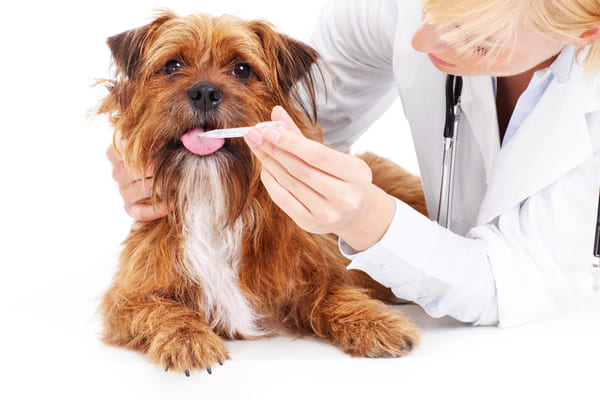

Can My Dog Have Diabetes?
Diabetes can shorten your dog’s life and dramatically affect their standard of living. Learn more about preventing and managing this common canine health concern.

Writer Animalia Team
8 min read

Like its human equivalent, canine diabetes is a condition in which your dog’s body is unable to produce or use insulin normally. Insulin is a hormone that plays a crucial role in helping blood sugar, also known as glucose, enter cells and be utilized for energy. If your dog doesn’t produce enough insulin or if your pet’s body is resistant to it, your dog will start accumulating excess glucose in their bloodstream. This will cause them to exhibit symptoms of diabetes.
While diabetes affects dogs of different breeds and sizes differently, all types of diabetes involve excessive levels of blood glucose, which can lead to serious health problems over time.
Types of Diabetes in Dogs
Dogs can have several different types of diabetes. The most common type is insulin-dependent diabetes, in which the pancreas doesn’t produce enough insulin to regulate blood sugar levels properly. Insulin-resistant diabetes is another common type of dog diabetes in which the body is resistant to insulin produced. Dogs suffering from diabetes are more likely to experience various health problems related to elevated blood glucose, including blindness, kidney disease, and heart disease.
In essence, the two main types of diabetes are:
- Type 1 – Insulin-dependent diabetes mellitus is an autoimmune condition in which the pancreas produces little or no insulin, so blood glucose levels rise excessively high when your dog eats.
- Type 2 – Insulin-resistant diabetes mellitus is linked to obesity, aging, and some genetic conditions. This type of insulin resistance occurs when cells fail to respond appropriately to insulin, causing higher blood glucose levels.
The causes of type 1 diabetes are unknown. It is an autoimmune disease in which the immune system mistakes insulin-producing cells for foreign invaders and begins to attack them. Type 2 diabetes is caused by obesity in dogs and genetics, but it can also occur due to environmental toxins such as high fructose corn syrup (HFCS).
Whichever type you suspect, you should always seek immediate medical attention if you believe your dog is diabetic.
What are the Signs and Symptoms of Diabetes in Dogs?
A dog with diabetes may exhibit symptoms including:
- Excessive thirst
- Increased appetite
- Frequent urination
- Weight loss
- Blurred vision and/or cloudy eyes.

In addition to these more obvious signs, symptoms of diabetes can include dry and rough looking-skin, as well as parched gums and tongue. As the disease progresses and blood glucose levels consistently rise higher than expected, a diabetic dog may develop an infection in the eyes, ears, or skin. Other diabetic puppy symptoms include decreased muscle strength, fatigue, and hyperglycemia.
Remember that many symptoms of diabetes aren’t recognized until serious damage has already been done. If you notice any of these signs of diabetes in dogs, make sure to get them checked out by a veterinarian as soon as possible. The vet can get to work immediately to stabilize the dog’s health and manage the condition. The sooner you catch the condition, the easier it will be to manage and ensure your dog lives a happy, healthy life.
What Can Make a Dog at Risk for Diabetes?
Several factors can increase a dog’s risk of developing potentially life-threatening diabetes. These include:
- Carrying excess weight
- A family history of diabetes
- Being over five years of age
- Suffering an immune-mediated illness like Cushing’s or certain types of cancers

The leading cause of diabetes in dogs is obesity. That’s just one of many reasons to ensure your dog eats a balanced, nutrient-rich diet and gets plenty of exercise. It’s tempting to offer treats whenever your pup asks, but avoiding excessive calories is an important part of staving off diabetes.
Treatment for Dogs with Diabetes
Dogs with Type 1 diabetes require insulin injections to keep blood glucose levels under control. Dogs with Type 2 diabetes, on the other hand, often require dietary changes to help lower blood glucose levels, medications to help restore insulin production, and/or insulin injections to keep glucose levels manageable.
Treatment for insulin resistance includes managing the dog’s weight, feeding a high-quality diet, and controlling blood glucose levels with medications such as insulin. The goal for any diabetic dog is to keep blood glucose levels as close to normal as possible so that the pancreas can remain healthy and produce insulin.
A healthy diet with low-fat content will help maintain a healthy weight and help normalize blood glucose levels in dogs with Type 2 diabetes. High-calorie foods should be kept away from diabetic dogs to prevent excess weight gain. Exercise and daily walks are also crucial.
As with humans, early detection is vital in preventing complications from diabetes such as blindness, kidney failure, and heart disease. If your dog develops any symptoms, contact your veterinarian immediately for recommendations on how to treat them effectively.
Monitoring and Managing Your Dog’s Diabetes
Diabetes can be an invisible disease, but that doesn’t mean you’re powerless to control it. You can take several steps to help manage your dog’s diabetes and prevent the disease from getting worse. Keeping a close eye on your dog’s blood glucose levels is key to keeping the condition in check. Fortunately, it’s easy with the right supplies and some simple techniques.
Here are some tips to help you monitor and manage your dog’s diabetes:
- When possible, measure your dog’s blood glucose levels prior to administering any type of medication, food, or snack. If necessary, contact your veterinarian to discuss potential adjustments in medication dosage or timing.
- Check your dog’s urine for high glucose levels (a color change from clear to yellow or brown) or glucose crystals (small, hard-to-see deposits). Once a week is usually a good target for monitoring. Make note of any spikes in urinary glucose early in the morning. These could be signs of dehydration and should be addressed immediately by adding water to your dog’s diet or administering oral medications (such as insulin). Also, make note of any instances of high-glucose urine late at night when the bladder is emptying (this could indicate a problem with urination).
- Look for blood-pressure changes while you’re out walking. Reduced blood flow can cause dizziness and fainting spells, especially at night.
- You can reduce the risk of diabetes by feeding your dog a healthy diet. A diet high in fiber and low in fat is best, but keep in mind that different dogs respond differently to certain foods. Be sure to adjust your dog’s diet according to their needs and in accordance with your vet’s recommendations.
- Regular exercise will help keep your dog’s blood sugar levels stable. Start small, such as taking your dog for a walk every day. Slowly increase the amount of time you spend walking.
- Keep an eye on your dog’s feet and eyes, especially if they are often chewing on unusual objects. If you notice any signs of infection, contact your veterinarian right away.
If you notice any unusual behavior changes in your dog — including increased licking of the feet — get them checked out as soon as possible.

How Serious is Diabetes in Dogs?
Diabetes affects approximately 6.7% of all dogs, according to the American Diabetes Association. It is one of the most notable causes of kidney disease in dogs, which can be fatal. If left untreated, diabetes can cause other serious health problems, including vision loss and heart disease.
Can canine diabetes be prevented?
Dog owners can prevent diabetes by always keeping their pets’ blood glucose levels under control. This means ensuring they don’t become overweight and keeping a careful eye out for signs of trouble.
Diabetes in dogs can be detected at an early age using a simple blood glucose test. Blood glucose levels are tested by taking a blood sample and testing it for glucose concentration. A normal range for blood glucose concentration ranges from 70mg/dL to 100mg/dL. A reading outside this range indicates that a dog has diabetes.
Up to 20% of all dogs diagnosed with diabetes have no identifiable genetic pattern predisposing them to the condition. Diabetic puppy symptoms can be detected as early as six weeks of age, but it is most likely to be discovered once a dog reaches the two-year mark.
Note that dogs rely on other measures to regulate blood sugar levels and not necessarily their pancreas. If a dog is overweight and experiencing insulin resistance, its body will produce more insulin than is necessary. These elevated insulin levels can lead to increased blood glucose, either directly or by causing an enzyme called phosphofructokinase to create glucose from non-carbohydrate molecules (glycogen).
Provide your pet with an insurance policy
Pet insurance is an excellent way to make sure you’re always prepared in the event of canine health emergencies. Purchased proactively, a policy can even help you to cover expenses associated with treating and managing diabetes. Make sure to review your options while your dog is young for the most robust coverage at the lowest price. Get a quote from Animalia today to learn more.





We offer the most
comprehensive coverage
out there
car with a spare tire for life’s bumps.
Having Animalia is like a pimped-out
Rolls Royce with a swimming pool
in the trunk.



Get your pet insurance quote
Pet type
- Dog
- Cat




